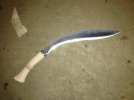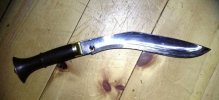- Joined
- Nov 11, 2013
- Messages
- 1,976
To figure out what shape/weight I prefer, I had to try a few.
In my very short journey to the Khukri world (7 pieces in about a month, from heavy to feather) I like pretty much everything I got here.

As a tool, my favorite weight/balance is the 20 ounce KLVUK and the least of my liking is this 28 ounce Villager. I'm not comfortable with such a drop.

What exactly is the goal/purpose for a drop like that?
Can someone tell me how to make the best use of this pronounced angle?
What kind of drop do you prefer and why?
In my very short journey to the Khukri world (7 pieces in about a month, from heavy to feather) I like pretty much everything I got here.

As a tool, my favorite weight/balance is the 20 ounce KLVUK and the least of my liking is this 28 ounce Villager. I'm not comfortable with such a drop.

What exactly is the goal/purpose for a drop like that?
Can someone tell me how to make the best use of this pronounced angle?
What kind of drop do you prefer and why?
Last edited:



